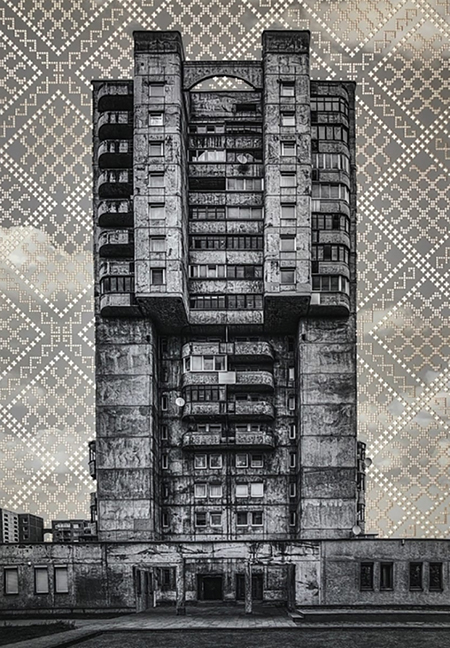
Through February 24, 2024
Recent photographs from Krista Svalbonas' “Displacement” series are included in her exhibition, “What Remains.” These laser-cut pigment prints fuse black and white photographs of facades of buildings shot during her travels to Lithuania, Latvia, and Germany (the birthplaces and early residences of her parents) with appropriated texts culled from personal letters from other displaced residents. Similarly, in her “What Remains” series itself, more post-industrial buildings are juxtaposed with decorative patterns that fill the space around the structures.
As a child of immigrants, Svalbonas "was always interested in ideas of home and dislocation." Researching, retracing and imagining her parent's origins amidst the turbulent political climate imposed upon them and their subsequent journey away from their homelands led her to displaced person camps in Germany, where refugees fleeing the Baltic States spent the years after WWII awaiting permission to emigrate to the United States. Through rigorous archival research, Svalbonas located numerous camps and traveled to Germany to document those that remain. Today, the buildings give little indication of their prior use or of those who once inhabited them.
In her “Displacement” series, Svalbonas describes the dwellings as "impersonal structures appropriated from other civilian and military uses." Photographed in situ they are printed in desaturated tonalities in which the architecture fills most of the frame. Within the computer, Svalbonas collages these images with texts from letters she discovered that were pleas for asylum sent by refugees to governments in the United States, United Kingdom and Canada. These words are typeset in dense overlapping rows that span the entire surface of the images and cover the buildings. The digital collages are printed and then fed into a laser cutter that etches the spaces between the letters to create an intricate, lace-like texture where the sky and foreground surrounding the buildings dissolve into a pattern of barely legible words.
“Lauingen” (2022) depicts a building in the town, which is located in the Bavarian district of Dillingen. The three-floor structure appears to be a traditional European residence, with numerous windows. The property is nicely landscaped and inviting. This contemporary image offers little about the building’s past. To provide context and content, Svalbonas overlays the photograph with a dense texture of words that create an evocative and unsettling juxtaposition. Because the condensed, overlapping type fuses with and disappears into the building, it is not possible to read the letter in its entirety. The salutation, "To Mrs Eleanor Roosevelt,” is visible in the upper left corner of the image.
Another plea appearing in the image “Geisligen” (2022) begins, "We Baltic Women in exile…" This text accompanies an image of a friendly tree-lined street with a variety of homes. The photograph representing Hamburg presents a multi-story apartment building apparently undergoing renovations as scaffolding is situated against the facade. The text reads: "June 1947 … To the […] board of Human Rights …" Although only fragments of the letter are clear, the content and urgency is evident, in contrast to the balanced and well composed architectural photographs.
With these delicate and mesmerizing works, Svalbonas investigates notions of memory as well as displacement as an attempt to retain and preserve a certain history before it disappears. In a recent interview, she stated "Each of these layered pieces becomes a puzzle I am struggling to complete before the history is lost forever, a composite of my own experience and the fading memories of my parents and their generation. My goal is to give voice to this near forgotten history that also speaks to the impact of contemporary forced migrations."
The images comprising the “What Remains’ series (2021-22) juxtapose black and white photographs from the Baltic regions of imposing Soviet architecture with complex and delicate textile patterns from traditional Baltic designs. There is a sharp contrast between the concrete, industrial architecture and the geometric cut-outs culled from folk-art patterns, which were often used for mittens, scarves and tablecloths as well as curtains. The voids in the prints that were removed by the laser cutter show a slightly burnt golden residue that references the past. According to Svalbonas, this work "examines the ways in which people are shaped by their environment, and how they can rebel against it to preserve their identity and culture."
These images couple objective photography (like that of, for instance, Bernd and Hilla Becher) with archival research that stems from personal stories. Seen together the photographs from both “Displacement” and “What Remains” speak with emotion to both the present and past.
